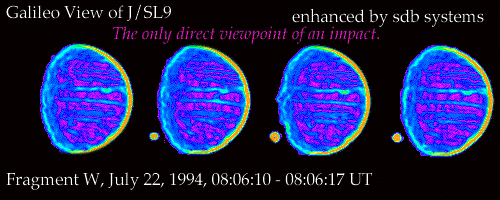

This image of the collision of comet fragment W consists of four frames taken over a 7-second period. It shows the beginning, brightening and fading of a bright point about 44 degrees south latitude on the far side of Jupiter from the Earth. The four frames were obtained on July 22, 1994, at a distance of about 150 million miles from Jupiter.
PUBLIC INFORMATION OFFICE JET PROPULSION LABORATORY CALIFORNIA INSTITUTE OF TECHNOLOGY NATIONAL AERONAUTICS AND SPACE ADMINISTRATION PASADENA, CALIF. 91109. TELEPHONE (818) 354-5011PHOTO CAPTION - August 19, 1994
These four images of Jupiter and the luminous night-side impact of fragment W of Comet Shoemaker-Levy 9 were taken by the Galileo spacecraft on July 22, 1994.
The spacecraft was 238 million kilometers (148 million miles) from Jupiter at the time, and 621 million kilometers from Earth. The spacecraft was about 40 degrees from Earth's line of sight to Jupiter, permitting this direct view. The images were taken at intervals of 2 1/3 seconds, using the green filter (visible light).
The first image, taken at an equivalent time to 8:06:10 Greenwich Mean Time (1:06 a.m. Pacific Daylight Time), shows no impact. In the next three images, a point of light appears, brightens so much as to saturate its picture element, and then fades again, seven seconds after the first picture. The location is approximately 44 degrees south as predicted; dark spots to the right are from previous impacts. Jupiter is approximately 60 picture elements in diameter.
Galileo tape-recorded most of its observations of the Shoemaker- Levy events during the second week of July 1994 and has since been playing the tape back selectively. Many more pictures and data from other instruments remain to be returned from the spacecraft's tape recorder. Playbacks will continue through January 1995.
It is not yet certain whether the data relate to meteor bolides (the comet fragment entering Jupiter's atmosphere) or to the subsequent explosion and fireball. Once all the Galileo, Hubble Space Telescope and ground-based data are integrated, an excellent start-to-finish characterization of these remarkable phenomena will be available.
The Galileo project, whose primary mission is the exploration of the Jupiter system in 1995 through 1997, is managed by the Jet Propulsion Laboratory for NASA's Office of Space Science.